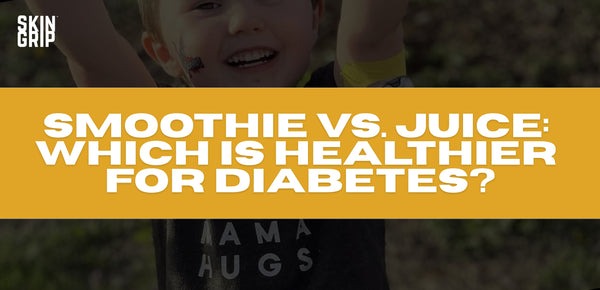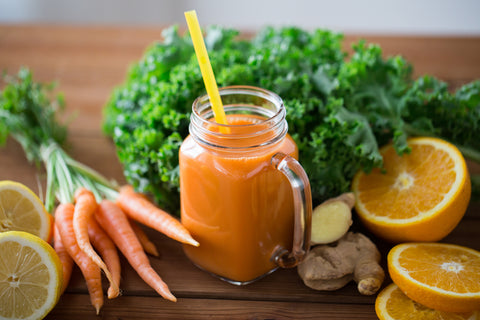*Disclaimer: All content and information in this blog is for informational and educational purposes only.
This article was medically reviewed by Amanda Ciprich, MS, RD. Last updated on 4/8/24.

The choice between smoothies and juices for individuals with diabetes involves considering various factors, including their impact on blood sugar levels, nutrient content and overall health benefit. Both smoothies and juices can be a part of a balanced diet, but the way they are prepared and the ingredients used can significantly influence their effect on blood sugar levels. In this blog post, we will explore the pros and cons of both smoothies and juices, providing insights into which option might be considered healthier for individuals with diabetes.
Do smoothies spike blood sugar levels?
Smoothies can have varying impacts on blood sugar levels depending on their ingredient composition. While smoothies that are made with a balance of protein, fat and fiber may have a more gradual impact on blood sugar levels compared to those with added sugars from fruit juices or sweeteners. If you’d like to create a blood sugar-friendly smoothie, use the following guidelines to assist in creating a smoothie that won’t spike your blood sugar.

How to make a smoothie that won’t spike your blood sugar with diabetes?
Making a smoothie that won’t cause spikes in blood sugar levels involves understanding how various ingredients impact blood sugars. This knowledge can empower you to make more informed decisions when preparing or ordering a blood sugar-friendly smoothie. To minimize the risk of blood sugar spikes, consider the following tips:
1. Be mindful of fruit content
Fruits contain natural sugars and fiber. While the fiber in blended smoothies can help regulate blood sugar levels, consuming large amounts of fruit can still lead to a significant rise. Opt for low glycemic fruits or be mindful of portion sizes for higher glycemic fruits.
2. Reduce added sugars
Some smoothies may include added sugars like honey, syrups or fruit juice. These added sugars can contribute to a quicker spike in blood sugar levels.
3. Increase fiber content
Including fiber in a smoothie can help slow down digestion and reduce the impact on blood sugar levels. Add fiber-rich ingredients like avocado, spinach, hemp seeds, or fresh fruit to achieve this.
4. Add protein and healthy fats
Incorporating sources of protein and healthy fats such as protein powder, greek yogurt, milk, nut butter or seeds can help stabilize blood sugar levels by slowing down the absorption of carbohydrates.
5. Overall Nutrient Balance
A well-balanced smoothie that includes a mix of carbohydrates, protein, and fats is less likely to cause a rapid spike in blood sugar levels compared to a smoothie that is high in sugars without any other stabilizing nutrients.
By focusing on these factors, you can create a nutrient-dense and balanced smoothie that is more gentle on your blood sugar levels. Adjusting ingredient choices and portion sizes according to your own individual needs and preferences will further contribute to a blood sugar-friendly smoothie option.
Pros and Cons of Smoothies with Diabetes
Pros:
- Fiber Rich: If made with whole fruits and vegetables, smoothies can provide dietary fiber which helps regulate blood sugar levels by slowing down the absorption of sugars.
- Sustained Energy: Smoothies can be a convenient way to pack a variety of nutrient-dense foods into one drink, including fruits, vegetables, protein, and healthy fats.
- Hydration: Smoothies often include liquid components which will contribute to hydration that is essential for overall health and can aid in managing blood sugars.
- Customization: Smoothies can be customized to suit individual taste preferences and nutritional needs, allowing for flexibility in ingredient selection.
- Quick and Convenient: Smoothies are quick to prepare and can be convenient on-the-go options.
Cons:
- Sugar Content: Commercially available or homemade smoothies with high amounts of fruit and added sugars can contribute to a rapid increase in blood sugar levels.
- Lack of Satiety: Some individuals may not feel as satisfied after consuming a smoothie compared to a solid meal, which could lead to increased snacking or overeating later.
- Processing and Fiber Loss: Over Blending fruits and vegetables can break down their fiber structure and potentially impact the way the body absorbs sugars leading to quicker spikes in blood sugar.
- Blood Sugar Spikes: If not properly balanced, smoothies may contribute to blood sugar spikes, especially if consumed in large quantities.
Does juicing spike blood sugar?
The effects of fresh juice on blood sugar levels can vary depending on its ingredient composition. When fruits and vegetables are juiced, the extraction process removes fiber, leaving behind 100% fresh fruit or vegetable juice. The impact on blood sugar may be less significant with 100% juice compared to juice containing added sugars. To make a juice that is gentle on blood sugar levels, consider the following guidelines to prevent spikes in blood sugar.

How to make diabetes-friendly juice
Making homemade juices that won’t cause spikes in blood sugar levels involves understanding how various ingredients impact blood sugars. This knowledge can empower you to make more informed decisions when juicing at home or on-the-go. To minimize the risk of blood sugar spikes, consider the following tips:
1. Use low glycemic ingredients
Opt for fruits and vegetables with a lower glycemic index such as berries, cherries, apples, cucumbers, celery, leafy greens and citrus fruits. When juicing, it is important to combine low glycemic fruits and vegetables to create a juice that is not only tasty but also has a more gradual impact on blood sugar levels.
You can enhance the flavor of your juice with herbs like mint or basil, or spices like ginger or cinnamon. These herbs and spices can enhance the flavor without significantly affecting blood sugar levels.
2. Consider dilution
Diluting 100% juice with water or adding ice can help reduce the concentration of sugars per serving.
3. Be mindful of portion sizes
Be mindful of the portion size of the juice consumed in one sitting. Even with blood sugar-friendly ingredients, a larger portion can contribute to a spike in blood sugar levels.
4. Avoid adding sweeteners
Minimize or avoid adding extra sweeteners such as sugar or honey to your juice. Allow the natural sweetness of fruits or vegetables to be the primary source of flavor.
5. Overall nutrient balance
Having juice with a balanced meal that includes protein, healthy fats and fiber-rich foods can help mitigate potential blood sugar spikes.
By focusing on these factors, you can create a nutrient-dense and balanced juice that is more gentle on your blood sugar levels. Adjusting ingredient choices and portion sizes according to your own individual needs and preferences will further contribute to a blood sugar-friendly juice option.
Pros and Cons for Juicing with Diabetes
Pros:
- Nutrient Concentration: Juicing can provide a concentrated source of vitamins, minerals, and antioxidants from a variety of fruits and vegetables.
- Hydration Boost: Juicing often involves using hydrating fruits and vegetables which can contribute to overall health and hydration status.
- Digestive Ease: The liquid form of juice may be gentler on the digestive system since all the fiber is removed making it easier for some individuals to consume essential nutrients.
- Variety of Flavors: Juicing allows for creative combinations of flavors making it enjoyable to consume a wide range of fruits and vegetables.
Cons:
- Sugar Content: Some juices can be high in natural and added sugars, leading to rapid spikes in blood sugar levels.
- Fiber Loss: Juicing removes much of the fiber found in whole fruits and vegetables. Fiber has a crucial role in digestion, satiety and blood sugar management. Its absence in juice can lead to faster absorption of sugars and potential blood sugar spikes
- Less Satiating: Liquid calories from juices may not be as satiating as whole foods.
- Expense and Waste: Juicing can be relatively expensive as the process often requires a larger quantity of produce. Additionally, the leftover pulp generates waste, and some argue that valuable nutrients are lost in the process.
Summary
Both smoothies and juicing can be a part of a healthy diet for individuals with diabetes, but there are key differences to consider. Paying attention to ingredients and portion sizes is essential for creating a health-conscious option. For personalized guidance tailored to individual needs and preferences, it’s recommended to consult with a healthcare provider or a registered dietitian.
About Amanda Ciprich, MS, RD
Amanda Ciprich, a registered dietitian with a specialization in type 1 diabetes, was diagnosed with T1D herself at the age of 18. With her expertise and personal experience, she has authored two books, including "The Caregiver's Guide to Diabetes: Practical Advice for Caring for Your Loved One." As the founder of T1D Nutritionist, a virtual insurance-based private practice, Amanda provides counseling and guidance to individuals with T1D and their families, supporting them in effectively managing diabetes.






























